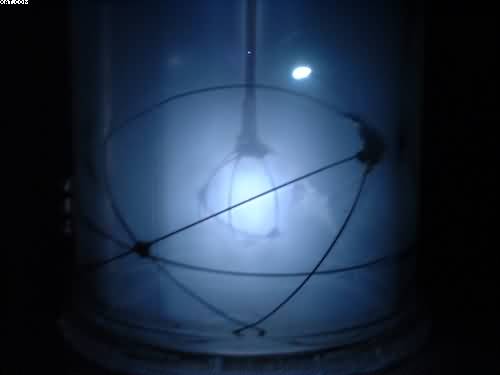

That sure is a strange looking lava lamp there in your living room.
In theory the fusor is perhaps the most promising form of fusion reactor studied. Energy is added to the fuel directly through acceleration, as opposed to the various indirect means required in a Tokamak or similar magnetically confined systems. Better yet, since the fusor is accelerating the ions (or electrons) directly, the range of velocities (or temperatures) is quite narrow. This means that most of the ions have enough energy to undergo fusion, whereas in a magnetically confined system it is typically only the "hottest" ions that can. Finally, failed collisions scatter inside the reaction area, heating other ions around them, thereby returning some of the energy to the reaction.Another advantage to the fusor is that any ion can be accelerated easily, not just the "low temperature" mixes like D-T. This makes the fusor particularly useful when running on other potential fusion fuels with much higher threshold temperatures. One of the most attractive such combinations is the proton - boron-11 reaction, which uses cheap natural isotopes, produces only helium, and produces neither neutrons nor gamma rays. This is a very clean reaction that would dramatically reduce waste when decommissioning a plant, and there is considerable interest in such aneutronic fuels.
Nothing in fusion is ever easy however. In the fusor a number of problems conspire to rob energy from the ions as they move towards the reaction area. One problem is the presence of "cooler" unionized particles of gas in the system, which can collide with the ions and cool them. Another problem is the presence of the inner electrodes, since ions often hit them and spray the reaction area with high-mass ions which soak up considerable energy from the surrounding fuel through collisions and then radiate the heat away as X-rays. This problem plagues traditional fusion designs as well, where it is known as sputtering.
A more serious concern was first outlined in 1994. In his doctoral thesis for MIT, Todd Rider did a theoretical study of all non-equilibrium fusion systems, of which the fusor is one of many. He demonstrated that all such systems will leak energy at a rapid rate due to Bremsstrahlung, radiation produced when electrons in the plasma hit other electrons or ions at a cooler temperature and suddenly decelerate. The problem is not as pronounced in a hot plasma because the range of temperatures, and thus the magnitude of the deceleration, is much less.
In most of the systems that he studied, the energy radiated away from the system was greater than the energy of the fusion itself. Unless a significant amount of energy from this radiation, namely X-rays, was captured, the system would never "break even". The problem is dependent on the mass of the fuel ions, so D-T and D-D fuels still provide net energy, but many of the more interesting aneutronic fuels appear to be impossible to use as an energy source.